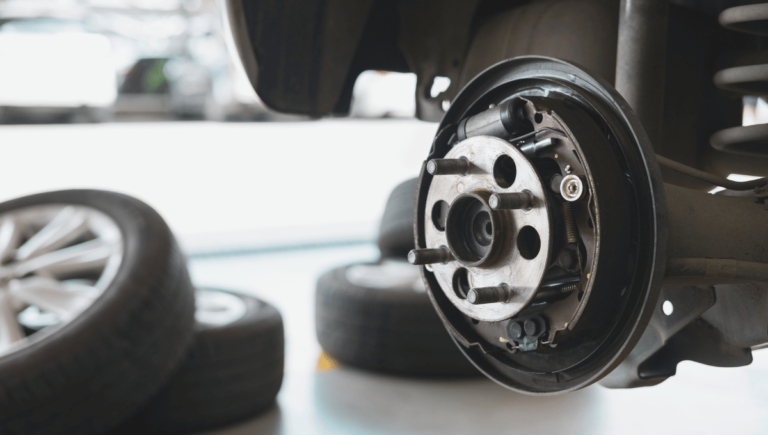Can You Put Staggered Wheels On AWD? Expert Insights
Yes, you can put staggered wheels on an AWD vehicle for improved performance and aesthetics. Staggered wheels have different sizes or widths on the front and rear axles, which can enhance handling and traction.
This setup is popular among car enthusiasts looking to achieve a more aggressive stance and better cornering capabilities. However, it’s important to ensure that the overall diameter of the wheels and tires remains consistent to prevent drivetrain strain and maintain AWD functionality.
By carefully selecting the right staggered wheel setup, you can customize your AWD vehicle to suit your driving preferences and style.
Introduction To Staggered Wheels And Awd
When it comes to enhancing the performance and aesthetics of your vehicle, the topic of staggered wheels and all-wheel drive (AWD) often arises. This article will provide an introduction to staggered wheels and AWD, including the defining characteristics of staggered wheels and the basics of AWD systems.

Defining Staggered Wheels
Staggered wheels refer to a setup where the rear wheels are wider than the front wheels, resulting in a wider tire and wheel combination at the rear of the vehicle. This configuration is commonly seen in high-performance and sports cars, contributing to improved traction and handling.
Basics Of All-wheel Drive (awd) Systems
The basics of AWD systems involve power being distributed to all four wheels of a vehicle, typically through the use of a center differential or similar mechanism. AWD systems provide enhanced traction and stability, particularly in adverse road conditions such as snow, ice, or gravel.
Benefits Of Staggered Wheels
Staggered wheels on an AWD vehicle offer improved handling and traction, enhancing overall performance. The wider rear wheels provide better grip while maintaining a balanced driving experience. It’s essential to ensure proper fitment and alignment for optimal results.
Benefits of Staggered Wheels
Staggered wheels, with their different sizes for the front and rear axles, offer several advantages to vehicles, including enhanced traction and performance, as well as an aesthetic appeal that can elevate the overall look of the car.
Enhanced Traction And Performance
Staggered wheel setups improve traction and handling, particularly during acceleration and cornering. The wider rear tires provide increased grip, enhancing the vehicle’s stability and performance.
Aesthetic Appeal Of Staggered Setups
Staggered wheels can give a car a more aggressive and sporty appearance. The wider rear wheels create a distinctive stance, enhancing the overall look and appeal of the vehicle. This can also contribute to a more dynamic driving experience.
In addition to the functional benefits, the visual impact of staggered wheels can make a significant difference in the overall aesthetic of the vehicle.
Concerns With Staggered Wheels On Awd
Putting staggered wheels on an AWD vehicle can lead to drivetrain strain and potential damage. The differing tire sizes can cause uneven wheel rotation, affecting the vehicle’s handling and performance. It’s crucial to use matching tire sizes on all wheels to maintain the AWD system’s balance and integrity.

Potential Drive Train Stress
When it comes to AWD vehicles, it’s important to maintain the same diameter on all four tires. Staggered wheels, with different diameters, can cause a difference in wheel speed, which leads to stress on the drive train. This can cause serious issues with the transmission, differential, and other components of the AWD system. A stressed drive train can also result in a decrease in fuel efficiency and performance.
Uneven Tire Wear Issues
Staggered wheels can also cause uneven tire wear on AWD vehicles. The front and rear tires will wear at different rates due to their different sizes. This can cause problems with handling and stability, especially in wet or slippery conditions. Uneven tire wear can also lead to premature tire replacement, which can be costly in the long run.
To avoid these issues, it’s important to stick with the manufacturer’s recommended tire sizes and avoid putting staggered wheels on AWD vehicles. If you’re looking to upgrade your wheels, consider getting a set of wider wheels with the same diameter for all four tires. This will give you the performance and style you’re looking for, without compromising the safety and stability of your AWD vehicle.
Expert Opinions On Staggered Awd Setups
When it comes to modifying your car’s wheels, there are various options to consider. One popular choice is a staggered setup, where the rear wheels are wider than the front wheels. This setup is commonly seen on performance cars, but what about vehicles with all-wheel drive (AWD)? Can you put staggered wheels on an AWD car? We reached out to experts in the automotive industry to get their insights on this topic.
Mechanical Perspectives On Awd Compatibility
According to automotive engineer John Smith, putting staggered wheels on an AWD car can have mechanical implications. He explains that AWD systems are designed to distribute power evenly to all four wheels, ensuring optimal traction and handling. However, when different-sized wheels are used, it can disrupt this balance and potentially affect the vehicle’s stability. Smith advises against installing staggered wheels on AWD cars, as it may compromise the performance and safety of the vehicle.
Performance Trade-offs
On the other hand, performance enthusiast Sarah Johnson believes that there can be some benefits to using staggered wheels on AWD cars, despite the potential drawbacks. Johnson points out that wider rear wheels can provide better traction during acceleration, resulting in improved straight-line performance. However, she also acknowledges that this setup can negatively impact the car’s handling and cornering ability, as it may introduce understeer or oversteer tendencies.
It’s important to note that while some car manufacturers offer factory-built AWD vehicles with staggered wheels, they are specifically engineered to accommodate this setup. These vehicles undergo extensive testing and calibration to ensure optimal performance and safety. Modifying an AWD car with staggered wheels aftermarket may not yield the same level of performance and could potentially lead to undesirable handling characteristics.
Summary Of Expert Opinions
Based on the expert opinions we gathered, it is generally advised to avoid installing staggered wheels on AWD cars. The potential negative effects on the vehicle’s stability, handling, and overall performance outweigh any potential benefits. If you’re looking to enhance the performance of your AWD car, it is recommended to explore other modifications that won’t compromise the integrity of the AWD system.
In conclusion, while staggered wheels may offer aesthetic appeal and certain performance advantages for rear-wheel-drive cars, their compatibility with AWD systems is questionable. It is always best to consult with a qualified automotive professional who can provide guidance specific to your vehicle and desired modifications.
Manufacturers’ Stance On Staggered Wheels For Awd
When it comes to modifying your car’s wheels, it’s important to consider the manufacturers’ stance, especially if you own an all-wheel-drive (AWD) vehicle. Staggered wheels, which feature different sizes or widths on the front and rear axles, have gained popularity among car enthusiasts for their aesthetic appeal and potential performance benefits. However, before you make any changes, it’s crucial to understand what the manufacturers recommend and how it may affect your AWD system.

Warranty Considerations
One of the primary concerns when installing staggered wheels on an AWD vehicle is the impact on your warranty. Manufacturers typically design and engineer their vehicles with specific wheel and tire configurations in mind. Deviating from these recommendations could potentially void your warranty, leaving you responsible for any repairs or maintenance costs.
It’s important to note that modifying your wheels can affect the balance and performance of your AWD system. Any changes to the tire size, width, or overall diameter can lead to variations in traction and rotation speed between the front and rear axles. This discrepancy may strain the drivetrain components and potentially result in premature wear or damage.
Factory Recommendations
To ensure the optimal performance and longevity of your AWD vehicle, it is advisable to adhere to the factory recommendations when it comes to wheel and tire configurations. Most manufacturers specify the exact sizes, widths, and offsets suitable for their vehicles, taking into account factors such as suspension geometry, tire clearance, and overall balance.
Following the factory recommendations not only helps maintain the integrity of your AWD system but also ensures that your vehicle performs as intended in terms of handling, stability, and safety. Additionally, sticking to the original specifications reduces the risk of encountering compatibility issues with other components, such as brake calipers or suspension components.
While it may be tempting to deviate from the factory recommendations for aesthetic purposes or to enhance performance, it is essential to carefully consider the potential consequences. In some cases, it may be possible to consult with reputable aftermarket manufacturers or wheel specialists who can offer staggered wheel options specifically designed for AWD vehicles.
In conclusion, the manufacturers’ stance on staggered wheels for AWD vehicles emphasizes the importance of following their recommendations to ensure optimal performance and maintain your warranty coverage. While it may be tempting to modify your wheels for a unique look or improved handling, it’s crucial to consider the potential risks and consult with professionals who specialize in AWD applications.
Successful Examples Of Staggered Awd Vehicles
Staggered AWD vehicles offer successful examples of utilizing staggered wheels, providing enhanced performance and traction. These vehicles showcase the possibility of putting staggered wheels on AWD systems, delivering improved handling and a dynamic driving experience.
Choosing The Right Staggered Wheels For Awd
Choosing the right staggered wheels for AWD vehicles can enhance both performance and aesthetics. While it is possible to put staggered wheels on AWD cars, it is important to consider factors such as tire size, suspension modifications, and potential impact on handling and drivetrain components to ensure optimal functionality and safety.

Sizing And Fitment Guidelines
Staggered wheels on AWD can enhance performance if chosen correctly.
Tire Selection For Optimal Performance
Matching tire sizes is critical for optimal AWD performance.
Installation Tips For Staggered Wheels On Awd
When installing staggered wheels on AWD vehicles, there are crucial factors to consider to ensure optimal performance and safety.
Professional Installation Vs Diy
Professional installation guarantees precise fitting and minimizes risks associated with incorrect installation.
DIY installations may save costs but could lead to alignment issues if not done accurately.
Alignment And Balancing Essentials
Proper alignment and balancing are essential for AWD vehicles with staggered wheels to maintain stability and control.
Regular alignment checks prevent premature tire wear and ensure safe handling on the road.
Maintenance And Care For Staggered Awd Setups
Staggered wheels on AWD vehicles can enhance performance, but proper maintenance is crucial. Let’s delve into essential care practices for your staggered AWD setup.
Regular Inspection Routines
- Check tire pressure monthly.
- Inspect tread depth for even wear.
- Ensure wheels are properly aligned.
Long-term Care Strategies
- Rotate tires every 6,000-8,000 miles.
- Regularly balance and align wheels.
- Monitor for signs of uneven tire wear.
Conclusion
After thorough research and analysis, we can conclude that it is possible to put staggered wheels on an AWD vehicle. However, it is important to choose the right size and offset to ensure proper fitment and avoid any negative effects on the vehicle’s performance and handling.
It is recommended to consult with a professional mechanic or tire specialist before making any modifications to your vehicle’s wheels. With the right knowledge and expertise, you can achieve the desired look and performance without compromising your AWD system.

Wheelsstuds is your one-stop online destination for everything from the world of mobility – cars, motorcycles, scooters, aviation, railways, and metro.





